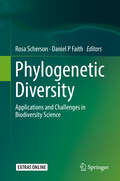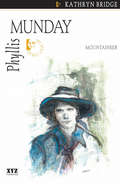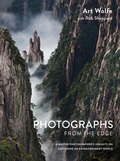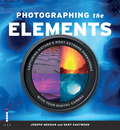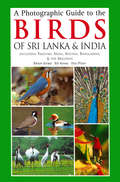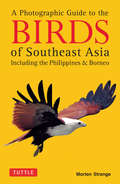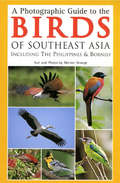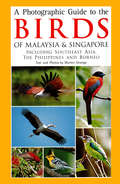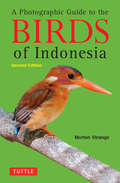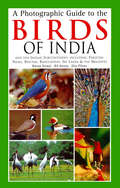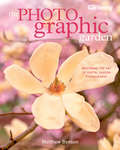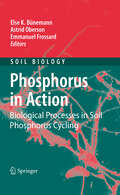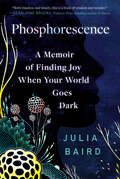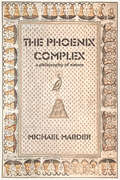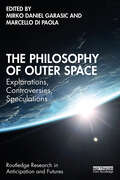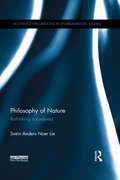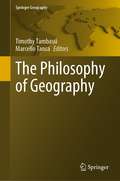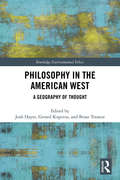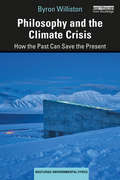- Table View
- List View
Phylogenetic Diversity: Applications and Challenges in Biodiversity Science
by Daniel P Faith Rosa A. Scherson“Biodiversity” refers to the variety of life. It is now agreed that there is a “biodiversity crisis”, corresponding to extinction rates of species that may be 1000 times what is thought to be “normal”. Biodiversity science has a higher profile than ever, with the new Intergovernmental Science-Policy Platform on Biodiversity and Ecosystem Services involving more than 120 countries and 1000s of scientists. At the same time, the discipline is re-evaluating its foundations – including its philosophy and even core definitions. The value of biodiversity is being debated. In this context, the tree of life (“phylogeny”) is emerging as an important way to look at biodiversity, with relevance cutting across current areas of concern – from the question of resilience within ecosystems, to conservation priorities for globally threatened species – while capturing the values of biodiversity that have been hard to quantify, including resilience and maintaining options for future generations.This increased appreciation of the importance of conserving “phylogenetic diversity”, from microbial communities in the human gut to global threatened species, has inevitably resulted in an explosion of new indices, methods, and case studies. This book recognizes and responds to the timely opportunity for synthesis and sharing experiences in practical applications. The book recognizes that the challenge of finding a synthesis, and building shared concepts and a shared toolbox, requires both an appreciation of the past and a look into the future. Thus, the book is organized as a flow from history, concepts and philosophy, through to methods and tools, and followed by selected case studies. A positive vision and plan of action emerges from these chapters, that includes coping with inevitable uncertainties, effectively communicating the importance of this “evolutionary heritage” to the public and to policy-makers, and ultimately contributing to biodiversity conservation policy from local to global scales.
Phyllis Munday
by Kathryn BridgeIn 1924 Phyllis (Phyl) Munday did what no other woman had done before - reached the summit of Mt. Robson. She climbed close to 100 mountains in her lifetime, many of those first ascents. She honed her outdoor skills as a Girl Guide leader and remained active in Guides throughout her life. During the 1920s and 1930s, Phyl and her partner Don Munday pioneered exploration into the heart of the Coast Mountains.
Photographs from the Edge: A Master Photographer's Insights on Capturing an Extraordinary World
by Art Wolfe Rob SheppardLegendary nature photographer Art Wolfe presents an intimate, behind-the-scenes guide to the experiences, decisions, and methods that helped him capture images from some of the most exciting locations across the globe. Wolfe takes you from the mountains of the Himalayas to the sandy shores of Mnemba Island, with stops in the crowded streets of India and the alkali lakes of Africa along the way. You'll learn the equipment, settings, and creative choices behind each photograph. From endangered species to cultural celebrations to natural wonders, Wolfe brings each subject to life through his stunning photography and the stories he shares in this one-of-a-kind photo safari.From the Hardcover edition.
Photographing the Elements: Capturing Nature's Most Extreme Phenomena With Your Digital Camera
by Gary Eastwood Joseph MeehanBlizzards, tornados, volcanic eruptions, and desert sandstorms? Forget about seeking shelter - these are the prime times to grab your gear and get one-of-a-kind photographs of the most exotic and extraordinary subjects on earth. Miles away from your typical landscape and nature shots, these powerful images are a stunning survey of natural wonders, a vibrant addition to any portfolio, and a testament to the adventurous spirit of the extreme photographer. Get out of your comfort zone and embrace the elements!
A Photographic Guide to the Birds of Sri Lanka & India
by Bill Harvey Bikram Grewal Otto PfisterPeriplus is proud to present the first comprehensive guide to the birds of the Indian subcontinent.This book covers over 800 species and distinct sub-species and contains over 1,000 full-color photographs. Each species has a distribution mapMany of the photographs in this magnificent volume appear for the first time and have been carefully selected to show the most important features of the species illustrated. In several cases, different plumages or flight shots are included. The concise text provides vital information on the plumages, voice and habits of each species are also mentioned in the texts. The maps are accompanied by a note on the status and distribution. This book will enable accurate field identification in one of the world's most diverse avifaunal regions. Indispensable reading for all bird lovers.
A Photographic Guide to the Birds of Southeast Asia
by Morten StrangeA Photographic Guide to the Birds of Southeast Asia is the first comprehensive photographic guide to the birds of mainland Southeast Asia, the Philippines and Borneo. It covers important bird species found in Malaysia, Singapore, Thailand, Cambodia and Vietnam, as well as southern China, Hong Kong, Taiwan and the Philippines.Of an estimated 10,000 living bird species in the world, Southeast Asia is home to over 3,000 of them-making this one of the most diverse avifaunal regions on the planet and a bird-watcher's paradise. This comprehensive guide covers over 660 species and has more than 700 color photographs. It is an invaluable guide to anyone planning a visit to Asia who is interested in birds. It gives a distribution map for each species and a checklist at the back.Many of the photographs in this book appear for the first time and have been carefully selected to illustrate the most important species and their key features. The text provides vital information to ensure accurate identifications. A Photographic Guide to the Birds of Southeast Asia is indispensable reading for bird lovers everywhere.
A Photographic Guide to the Birds of Southeast Asia
by Morten StrangePeriplus is proud to present the very first comprehensive photographic guide to the birds of mainland Southeast Asia, the Philippines and Borneo. Included are the birds of Peninsular Malaysia, Thailand and Indochina, as well as those found in South China, Hong Kong and Taiwan.This book covers 668 species and contains more than 700 color photographs. There is a distribution map for each species.Many of the photographs in this magnificent volume appear for the first time and have been carefully selected to show the most important species. The concise text provides vital information that will ensure accurate identification of species in one of the most diverse avifauna regions. Indispensable reading for all bird lovers.
A Photographic Guide to the Birds of Southeast Asia
by Morten StrangePeriplus is proud to present the very first comprehensive photographic guide to the birds of mainland Southeast Asia, the Philippines and Borneo. Included are the birds of Peninsular Malaysia, Thailand and Indochina, as well as those found in South China, Hong Kong and Taiwan.This book covers 668 species and contains more than 700 color photographs. There is a distribution map for each species.Many of the photographs in this magnificent volume appear for the first time and have been carefully selected to show the most important species. The concise text provides vital information that will ensure accurate identification of species in one of the most diverse avifauna regions. Indispensable reading for all bird lovers.
A Photographic Guide to the Birds of Malaysia & Singapore: Including Southeast Asia, the Philippines and Borneo
by Morten StrangePeriplus is proud to present the very first comprehensive photographic guide to the birds of Malaysia and Singapore, mainland Southeast Asia, the Philippines and Borneo.<P><P> Included are the birds of Thailand and Indochina, as well as those found in South China, Hong Kong and Taiwan.This book covers 668 species and contains more than 700 color photographs. There is a distribution map for each species.Many of the photographs in this magnificent volume appear for the first time and have been carefully selected to show the most important species. The concise text provides vital information that will ensure accurate identification of species in one of the world's most diverse avifauna regions. Indispensable reading for all bird lovers.
A Photographic Guide to the Birds of Indonesia
by Morten Strange[A Photographic Guide to the Birds of Indonesia is a newly revised edition of the first-and best-comprehensive photographic guide to the birds of Indonesia.] Because of its vast size and geographical location, Indonesia has the world's most diverse avifauna. It boasts of more than 1,600 species-of which 235 species are only found in Indonesia, making it the world's number one travel destination for bird-watching.[This book covers a total of 912 species, including most of the non-migratory and endemic species that are seen only in Indonesia. A photograph and distribution map is given for each bird.] Many new photographs appear in this volume for the first time and have been carefully selected to show the important characteristics of each bird. [The concise text provide vital information, and an index of common names is provided at the back of the book.]
A Photographic Guide to the Birds of Indonesia
by Morten Strange[A Photographic Guide to the Birds of Indonesia is a newly revised edition of the first-and best-comprehensive photographic guide to the birds of Indonesia.] Because of its vast size and geographical location, Indonesia has the world's most diverse avifauna. It boasts of more than 1,600 species-of which 235 species are only found in Indonesia, making it the world's number one travel destination for bird-watching.[This book covers a total of 912 species, including most of the non-migratory and endemic species that are seen only in Indonesia. A photograph and distribution map is given for each bird.] Many new photographs appear in this volume for the first time and have been carefully selected to show the important characteristics of each bird. [The concise text provide vital information, and an index of common names is provided at the back of the book.]
A Photographic Guide to the Birds of India
by Bikram GrewalPeriplus is proud to present the first comprehensive photographic guide to the birds of the Indian subcontinent. This ebook offers over 800 species and distinct sub-species and contains over 1,000 full-color photographs. Each species has a distribution map. Many of the photographs in this magnificent volume appear for the first time and have been carefully selected to show the most important features of the species illustrated. In several cases, different plumages or flight shots are included. The concise text provided vital information on the plumages, voice and habits of each species covered and includes new information. Over a hundred related species are also mentioned in the texts. The maps are accompanied by a note on the status and distribution. This ebook will enable accurate field identification in one of the world's most diverse avifaunal regions. Indispensable reading for all bird lovers.
A Photographic Guide to the Birds of India
by Bikram GrewalPeriplus is proud to present the first comprehensive photographic guide to the birds of the Indian subcontinent. This ebook offers over 800 species and distinct sub-species and contains over 1,000 full-color photographs. Each species has a distribution map. Many of the photographs in this magnificent volume appear for the first time and have been carefully selected to show the most important features of the species illustrated. In several cases, different plumages or flight shots are included. The concise text provided vital information on the plumages, voice and habits of each species covered and includes new information. Over a hundred related species are also mentioned in the texts. The maps are accompanied by a note on the status and distribution. This ebook will enable accurate field identification in one of the world's most diverse avifaunal regions. Indispensable reading for all bird lovers.
A Photographic Guide to the BIRDS OF INDIA
by Bikram Grewal Bill Harvey Otto PfisterThis guide covers 800 species found in India. Each species description is illustrated with a photograph and distribution map, making this a quick-reference guide in a pocketable format. Introductory sections include general information, such as the biogeography of the region covered.
Photographic Guide to Longhorned Beetles of Bolivia: Guía Fotográfica de Escarabajos Longicornios de Bolivia
by James Earl Wappes Julieta Ledezma Arias Steven Wayne LingafelterWith loss of habitats throughout the world occurring at a staggering rate, it is critical to document what is being lost. This book strives to do that by focusing on longhorned woodboring beetles in Bolivia. Wholesale clearing of large tracts of land kills everything or forces species to move quickly to other areas, disrupting the balance of the ecosystem. This book will help people discover and appreciate some of the amazing diversity of life that exists in the undeveloped and/or remote natural areas of Bolivia. Nearly 1,900 species of longhorned woodboring beetles (Disteniidae, Vesperidae, and Cerambycidae) are known from Bolivia (with more than 200 species yet to be determined). This work features 500 of them, representing the breadth of morphological evolution.
The Photographic Garden: Mastering the Art of Digital Garden Photography
by Matthew BensonThe garden is a rich canvas of visual ideas, all waiting to be skillfully captured and evoked by the camera. With in-depth discussions on creative technique and technical literacy, The Photographic Garden is an inspiring guide for understanding the complexities of light and design in the garden and a primer on the latest digital image-making tools, from cameras to postproduction software. Professional photographer Matthew Benson shows you how to become a better, more intuitive artist in the landscape; helps you foster a deeper understanding of design and aesthetics; and encourages you to develop your own visual sensibility—through hundreds of his own thoughtprovoking, evocative garden images. You'll learn how to explore the garden with your camera; how to apply the fundamentals of composition, light, and color to image-making; and how to use digital technology to improve and enhance (and even rescue!) the images you've taken. Most of all, you'll be motivated to see like a camera, work like a professional, and imagine and create like an artist.
Phosphorus in Action
by Astrid Oberson Else K. Bünemann Emmanuel FrossardPhosphorus (P) is a finite resource which is essential for life. It is a limiting nutrient in many ecosystems but also a pollutant which can affect biodiversity in terrestrial ecosystems and change the ecology of water bodies. This book collects the latest information on biological processes in soil P cycling, which to date have remained much less understood than physico-chemical processes. The methods section presents spectroscopic techniques and the characterization of microbial P forms, as well as the use of tracers, molecular approaches and modeling of soil-plant systems. The section on processes deals with mycorrhizal symbioses, microbial P solubilization, soil macrofauna, phosphatase enzymes and rhizosphere processes. On the system level, P cycling is examined for grasslands, arctic and alpine soils, forest plantations, tropical forests, and dryland regions. Further, P management with respect to animal production and cropping, and the interactions between global change and P cycling, are treated.
Phosphorescence: A Memoir of Finding Joy When Your World Goes Dark
by Julia Baird&“Both timeless and timely, this is a book of wisdom and wonder&” (Geraldine Brooks, Pulitzer Prize–winning author of March), a deeply personal exploration of what can sustain us through our darkest moments.&“What has fascinated and sustained me over these last few years has been the notion that we have the ability to find, nurture, and carry our own inner, living light—a light to ward off the darkness. This is not about burning brightly; it&’s about yielding a more simple phosphorescence—being luminous, having stored light for later use. Staying alive, remaining upright, even when lashed by doubt.&” After surviving a difficult heartbreak and battle with cancer, acclaimed author and columnist Julia Baird began thinking deeply about how we, as people, persevere through the most challenging circumstances. She started to wonder, when we are overwhelmed by illness, loss or pain, or a tragedy outside our control: How can we keep putting one foot in front of the other? Baird went in search of the magic that fuels the light within—our own phosphorescence. In this stunning book, she reflects on the things that lit her way through the darkness, especially the surprising strength found in connecting with nature and not just experiencing awe and wonder about the world around her, but deliberately hunting it, daily. Baird also writes about crossbeams of resilience: nurturing friendships and a quiet faith, pursuing silence, fighting for what she believes in, the importance of feeling small, learning from her mother's example of stoic grace. She also explores how others nurture their inner light, interviewing the founder of the modern forest therapy movement in Tokyo, a jellyfish scientist in Tasmania, and a tattooed priest from Colorado, among others. Weaving together candid and moving memoir with deep research and reflections on nature and the world around her, Baird inspires readers to embrace new habits and to adopt a phosphorescent outlook on life, to illuminate ourselves and our days—even in the darkest times.
The Phoenix Complex: A Philosophy of Nature
by Michael MarderAn innovative, wide-ranging consideration of the global ecological crisis and its deep philosophical and theological roots.Global crises, from melting Arctic ice to ecosystem collapse and the sixth mass extinction, challenge our age-old belief in nature as a phoenix with an infinite ability to regenerate itself from the ashes of destruction. Moving from antiquity to the present and back, Michael Marder provides an integrated examination of philosophies of nature drawn from traditions around the world to illuminate the theological, mythical, and philosophical origins of the contemporary environmental emergency. From there, he probes the contradictions and deadlocks of our current predicament to propose a philosophy of nature for the twenty-first century.As Marder analyzes our reliance on the image and idea of the phoenix to organize our thoughts about the natural world, he outlines the obstacles in the path of formulating a revitalized philosophy of nature. His critical exposition of the phoenix complex draws on Chinese, Indian, Russian, European, and North African traditions. Throughout, Marder lets the figure of the phoenix guide readers through theories of immortality, intergenerational and interspecies relations, infinity compatible with finitude, resurrection, reincarnation, and a possibility of liberation from cycles of rebirth. His concluding remarks on a phoenix-suffused philosophy of nature and political thought extend from the Roman era to the writings of Hannah Arendt.
The Philosophy of Outer Space: Explorations, Controversies, Speculations (Routledge Research in Anticipation and Futures)
by Mirko Daniel Garasic Marcello Di PaolaThis volume provides a rigorous philosophical investigation of the rationales, challenges, and promises of the coming Space Age.Over the past decade, space exploration has made significant and accelerating progress, and its potential has attracted growing attention from science, states, businesses, innovators, as well as the media and society more generally. Yet philosophical theorizing concerning the premises, values, meanings, and impacts of space exploration is still in its infancy, and this potentially immense field of study is far from mainstream yet. This book advances outer space philosophy by integrating key scientific and societal debates sparked by recent developments in space research and activities with conceptual, existential, ethical, aesthetic, and political themes and concerns. It maps various regions of philosophical exploration, reflection, and speculation regarding humanity’s present and future emanations into outer space, to promote a broad, rich, and nuanced societal debate regarding this transformative enterprise, which is as stimulating as it can be disorienting.This book will be a fascinating read for academics, researchers, and students interested in philosophy, space studies, science and technology studies, future studies, and sustainability.
Philosophy of Nature: Rethinking naturalness (Routledge Explorations in Environmental Studies)
by Svein Anders LieThe concept of naturalness has largely disappeared from the academic discourse in general but also the particular field of environmental studies. This book is about naturalness in general – about why the idea of naturalness has been abandoned in modern academic discourse, why it is important to explicitly re-establish some meaning for the concept and what that meaning ought to be. Arguing that naturalness can and should be understood in light of a dispositional ontology, the book offers a point of view where the gap between instrumental and ethical perspectives can be bridged. Reaching a new foundation for the concept of ‘naturalness’ and its viability will help raise and inform further discussions within environmental philosophy and issues occurring in the crossroads between science, technology and society. This topical book will be of great interest to researchers and students in Environmental Studies, Environmental Philosophy, Science and Technology Studies, Conservation Studies as well as all those generally engaged in debates about the place of ‘man in nature’.
The Philosophy of Geography (Springer Geography)
by Timothy Tambassi Marcello TancaThe relationship between geography and philosophy is still largely in need of being explored. Geographers and philosophers share the responsibility for that. On the one hand, geographers have considered as a dangerous deviation any attempt to elaborate an image of the Earth which was not a mere replica of a cartographic representation. On the other hand, philosophers have generally been uninterested in a discipline offering little chance for critical reflection. In light of these considerations, the purpose of this book is to identify some fundamental philosophical issues involved in the reflection of geography by adopting a perspective which looks at the discipline with a specific focus on its fundamental concepts and distinctions.
Philosophy in the American West: A Geography of Thought (Routledge Environmental Ethics)
by Josh Hayes Gerard Kuperus Brian TreanorPhilosophy in the American West explores the physical, ecological, cultural, and narrative environments associated with the western United States, reflecting on the relationship between people and the places that sustain them. The American West has long been recognized as having significance. From Crèvecoeur’s early observations in Letters from an American Farmer (1782), to Thoreau’s reflections in Walden (1854), to twentieth-century thoughts on the legacy of a vanishing frontier, "the West" has played a pivotal role in the American narrative and in the American sense of self. But while the nature of "westernness" has been touched on by historians, sociologists, and, especially, novelists and poets, this collection represents the first attempt to think philosophically about the nature of "the West" and its influence on us. The contributors take up thinkers that have been associated with Continental Philosophy and pair them with writers, poets, and artists of "the West". And while this collection seeks to loosen the cords that tie philosophy to Europe, the traditions of "continental" philosophy—phenomenology, hermeneutics, deconstruction, and others—offer deep resources for thinking through the particularity of place. This book will be of great interest to students and scholars of Philosophy, as well as those working in Ecocriticism and the Environmental Humanities more broadly.
Philosophy and the Climate Crisis: How the Past Can Save the Present (Routledge Environmental Ethics)
by Byron WillistonThis book explores how the history of philosophy can orient us to the new reality brought on by the climate crisis. If we understand the climate crisis as a deeply existential one, it can help to examine the way past philosophers responded to similar crises in their times. This book explores five past crises, each involving a unique form of collective trauma. These events—war, occupation, exile, scientific revolution and political revolution—inspired the philosophers to remake the whole world in thought, to construct a metaphysics. Williston distills a key intellectual innovation from each metaphysical system: • That political power must be constrained by knowledge of the climate system (Plato) • That ethical and political reasoning must be informed by care or love of the ecological whole (Augustine) • That we must enhance the design of the technosphere (Descartes) • That we must conceive the Earth as an internally complex system (Spinoza) • And that we must grant rights to anyone or anything—ultimately the Earth system itself—whose vital interests are threatened by the effects of climate change (Hegel). Philosophy and the Climate Crisis will be of great interest to students and scholars of climate change, environmental philosophy and ethics and the environmental humanities.
